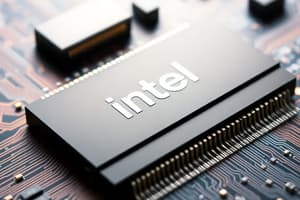Podcast
Questions and Answers
What is a key feature of the Intel 8086 microprocessor?
What is a key feature of the Intel 8086 microprocessor?
- 24-bit data bus
- 16-bit data bus (correct)
- 8-bit data bus
- 20-bit data bus
Which type of registers in the 8086 microprocessor are used for addressing memory segments?
Which type of registers in the 8086 microprocessor are used for addressing memory segments?
- Segment registers (correct)
- General-purpose registers
- Instruction pointer
- Special registers
In the 8086 microprocessor, what does the instruction pointer (IP) indicate?
In the 8086 microprocessor, what does the instruction pointer (IP) indicate?
- Current memory location for data storage
- Interrupt vector address
- Next instruction to be executed (correct)
- Last executed instruction
What does the flags register in the 8086 microprocessor primarily store?
What does the flags register in the 8086 microprocessor primarily store?
What type of memory architecture does the 8086 microprocessor have?
What type of memory architecture does the 8086 microprocessor have?
What is the main responsibility of the bus interface unit (BIU) in the 8086 microprocessor?
What is the main responsibility of the bus interface unit (BIU) in the 8086 microprocessor?
Which of the following is NOT a type of register in the 8086 microprocessor?
Which of the following is NOT a type of register in the 8086 microprocessor?
Which unit in the 8086 microprocessor is responsible for managing data transfer between the microprocessor and memory or I/O devices?
Which unit in the 8086 microprocessor is responsible for managing data transfer between the microprocessor and memory or I/O devices?
How many vectored interrupts does the 8086 microprocessor support?
How many vectored interrupts does the 8086 microprocessor support?
What type of architecture does the 8086 microprocessor have?
What type of architecture does the 8086 microprocessor have?
In terms of tasks handling, what advantage does the CISC architecture of the 8086 provide?
In terms of tasks handling, what advantage does the CISC architecture of the 8086 provide?
What was a significant advancement introduced by the Intel 8086 microprocessor?
What was a significant advancement introduced by the Intel 8086 microprocessor?
Study Notes
Microprocessor 8086: A Historical Overview
The Intel 8086 microprocessor, also known as the iAPX 86, is a significant milestone in the history of microprocessors. Designed by Intel between 1976 and 1978, the 8086 was the first 16-bit microprocessor, offering a 16-bit data bus and 20-bit address bus that could address up to 1 MB of memory. It was the first member of the x86 family of microprocessors, which has become the most successful line of processors for personal computers and servers.
Registers
The 8086 microprocessor has a rich set of registers, including:
- General-purpose registers: These registers can be used to store data and perform arithmetic and logical operations.
- Segment registers: These registers are used to address memory segments.
- Special registers: The most notable ones are the flags register, which stores status information about the result of the previous operation, and the instruction pointer (IP), which points to the next instruction to be executed.
Memory Interfacing
The 8086 microprocessor has a segmented memory architecture, where memory is divided into segments that are addressed using both a segment register and an offset. This allows the microprocessor to access large amounts of memory while still using a 16-bit data bus.
Instruction Set
The 8086 microprocessor has a complex instruction set computer (CISC) architecture, which means that it supports a wide range of instructions, many of which can perform multiple operations in a single instruction. This architecture allows for efficient handling of a wide range of tasks.
Architecture
The 8086 microprocessor has two main execution units: the execution unit (EU) and the bus interface unit (BIU). The BIU is responsible for fetching instructions from memory and decoding them, while the EU executes the instructions. The BIU also manages data transfer between the microprocessor and memory or I/O devices.
Interrupts
The 8086 microprocessor has 256 vectored interrupts, which are used to handle external events and requests. These interrupts help in synchronizing the microprocessor with external devices and provide a mechanism for efficient co-processing.
Conclusion
The Intel 8086 microprocessor was a significant advancement in microprocessor technology when it was released in 1978. It introduced a 16-bit architecture, which became the standard for personal computers and servers. While it has limited performance compared to modern microprocessors, its rich instruction set and segmented memory architecture allowed for efficient handling of a wide range of tasks. The legacy of the 8086 is still visible in today's personal computers and servers, as it laid the foundation for the x86 architecture, which continues to be Intel's most successful line of processors.
Studying That Suits You
Use AI to generate personalized quizzes and flashcards to suit your learning preferences.
Description
Test your knowledge about the Intel 8086 microprocessor, a groundbreaking 16-bit processor that laid the foundation for modern personal computers and servers. Explore its architecture, registers, memory interfacing, instruction set, interrupts, and historical significance.




